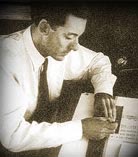Approaching History
StylePeople differ in ability. Fine. History needs a lot of help, and it can find work for all those people. What is less often recognized is that people of equal ability may differ in mental style. Their temperaments are well aligned for certain kinds of problem, and not so well for other kinds. So also with mathematicians: some like to think in diagrams (the geometers), and others do without them altogether (the algebraists). Neither is better, each is good, both together make a richer science. Here is an example:
There exists a theory, the theory of groups, the importance of which, in our science, grew increasingly . . . since the work of Sophus Lie at the end of the nineteenth century. Some mathematicians, especially contemporary ones, have improved it by most beautiful discoveries. Some others - I confess that I belong to the latter category - though being eventually able to use it for simple applications, feel insuperable difficulty in mastering more than a rather elementary and superficial knowledge of it. Psychological reasons for that difference, which seems to me to be incontestable, would be interesting to find. (Hadamard Psychology 115)
It would be foolish to define one of these types as "real mathematics" and exclude the other.
For a parallel in the humanistic sciences, we have this description of Ventris by his colleague and survivor Chadwick. The learned persons of the world had labored in vain to crack the Linear B script. Ventris was not a savant, he did not even have a degree; he was, as Myres said in disdain, "a young architect." How could he possibly succeed where they had failed? Chadwick's answer:
If we ask what were the special qualities that made possible his achievement, we can point to his capacity for infinite pains, his powers of concentration, his meticulous accuracy, his beautiful draughtsmanship. . . . His brain worked with an astonishing rapidity, so that he could think out all the implications of a suggestion almost before it was out of your mouth. He had a keen appreciation of the realities of a situation: the Mycenaeans were to him no vague abstractions, but living people whose thoughts he could penetrate. He himself laid stress on the visual approach to the problem: he made himself so familiar with the visual aspect of the texts that large sections were imprinted on his mind simply as visual patterns, long before the decipherment gave them meaning. But a merely photographic memory was not enough, and it was here that his architectural training came to his aid. The architect's eye sees in a building not a mere façade, a jumble of ornamental and structural features; it looks beneath the appearance and distinguishes the significant parts of the pattern, the structural elements and framework of the building. So too Ventris was able to discern among the bewildering variety of the mysterious signs, patterns and regularities which betrayed the underlying structure. It is this quality, the power of seeing order in apparent confusion, that has marked the work of all great men.
The conventional skills are noted at the beginning. The sovereign skill of all discoverers, the sense of pattern, is given at the end. All that is correct. But the answer to our question is Ventris's own comment in the middle. He was a spatial thinker; he could visualize. Here is where he diverged from other people with good memories, or with an appreciation of the regularities in the data. It was his visualization skills that set him apart from his several dozen rivals for the honor of this particular discovery. Feynman too was visual. Here we see him detecting a logical fallacy:
I had a scheme, which I still use today when somebody is explaining something that I am trying to understand: I keep making up examples. For instance, the mathematicians would come in with a terrific theorem, and they're all excited. As they're telling me the conditions of the theorem, I construct something which fits all the conditions. You know, you have a set (one ball), disjoint (two balls). Then the balls turn colors, grow hairs, or whatever, in my head as they put more conditions on. Finally they state the theorem, which is some dumb thing about the ball which isn't true for my hairy green ball thing, so I say, "False!"
This does not mean that deans should rush out and hire visual types. Numerical types too have their place and their advantage. So do verbal types. The moral for deans is to mix types. For the individual who IS a type, and probably cannot do much about it, the only advice is to work on things congenial to your instincts. And, as the the individual counterpart of the wisdom of deans, try to be in touch with people who possess the complementary skills. No frog can jump very far on one leg.
Readings
- W I B Beveridge. The Art of Scientific Investigation. 1950; 2ed Norton 1957
- Jacques Hadamard. The Psychology of Invention in the Mathematical Field. Princeton 1945
- Peter Gay. Style in History
- John Chadwick. The Decipherment of Linear B. Cambridge 1958
17 Mar 2006 / Contact The Project / Exit to Outline Index Page
![Jacques Hadamard (1865-1963). His most important result is the Prime Number Theorem (1896), which holds that the number of primes less than n tends to infinity at the same rate as does n/log[e]n.](../../../images/hadamard.jpg)
